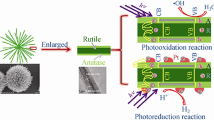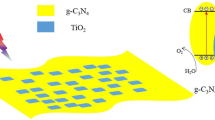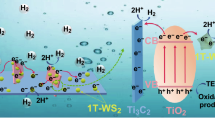Abstract
Heterostructure is an effective strategy to facilitate the charge carrier separation and promote the photocatalytic performance. In this paper, uniform SrTiO3 nanocubes were in-situ grown on TiO2 nanowires to construct heterojunctions. The composites were prepared by a facile alkaline hydrothermal method and an in-situ deposition method. The obtained SrTiO3/TiO2 exhibits much better photocatalytic activity than those of pure TiO2 nanowires and commercial TiO2 (P25) evaluated by photocatalytic water splitting and decomposition of Rhodamine B (RB). The hydrogen generation rate of SrTiO3/TiO2 nanowires could reach 111.26 mmol·g−1·h−1 at room temperature, much better than those of pure TiO2 nanowires (44.18 mmol·g−1·h−1)and P25 (35.77 mmol·g−1·h−1). The RB decomposition rate of SrTiO3/TiO2 is 7.2 times of P25 and 2.4 times of pure TiO2 nanowires. The photocatalytic activity increases initially and then decreases with the rising content of SrTiO3, suggesting an optimum SrTiO3/TiO2 ratio that can further enhance the catalytic activity. The improved photocatalytic activity of SrTiO3/TiO2 is principally attributed to the enhanced charge separation deriving from the SrTiO3/TiO2 heterojunction.
Similar content being viewed by others
References
Xie Z, Feng Y, Wang F, et al. Construction of carbon dots modified MoO3/g-C3N4 Z-scheme photocatalyst with enhanced visible-light photocatalytic activity for the degradation of tetracycline. Applied Catalysis B: Environmental, 2018, 229: 96–104
Sang Y, Zhao Z, Zhao M, et al. From UV to near-infrared, WS2 nanosheet: a novel photocatalyst for full solar light spectrum photodegradation. Advanced Materials, 2015, 27(2): 363–369
Dong S, Ding X, Guo T, et al. Self-assembled hollow sphere shaped Bi2WO6/RGO composites for efficient sunlight-driven photocatalytic degradation of organic pollutants. Chemical Engineering Journal, 2017, 316: 778–789
Sun Q, Wang N, Yu J, et al. A hollow porous CdS photocatalyst. Advanced Materials, 2018, 30(45): 1804368
Shi R, Cao Y, Bao Y, et al. Self-assembled Au/CdSe nanocrystal clusters for plasmon-mediated photocatalytic hydrogen evolution. Advanced Materials, 2017, 29(27): 1700803
Wei R B, Huang Z L, Gu G H, et al. Dual-cocatalysts decorated rimous CdS spheres advancing highly-efficient visible-light photocatalytic hydrogen production. Applied Catalysis B: Environmental, 2018, 231: 101–107
Zhou M, Wang S, Yang P, et al. Boron carbon nitride semiconductors decorated with CdS nanoparticles for photocatalytic reduction of CO2. ACS Catalysis, 2018, 8(6): 4928–4936
Jin J, Yu J, Guo D, et al. A hierarchical Z-scheme CdS-WO3 photocatalyst with enhanced CO2 reduction activity. Small, 2015, 11(39): 5262–5271
Kuehnel M F, Orchard K L, Dalle K E, et al. Selective photocatalytic CO2 reduction in water through anchoring of a molecular Ni catalyst on CdS nanocrystals. Journal of the American Chemical Society, 2017, 139(21): 7217–7223
Fujishima A, Honda K. Electrochemical photolysis of water at a semiconductor electrode. Nature, 1972, 238(5358): 37–38
Zhang P, Yu L, Lou X W D. Construction of heterostructured Fe2O3-TiO2 microdumbbells for photoelectrochemical water oxidation. Angewandte Chemie International Edition, 2018, 57 (46): 15076–15080
Gao C, Wei T, Zhang Y, et al. A photoresponsive rutile TiO2 heterojunction with enhanced electron-hole separation for high-performance hydrogen evolution. Advanced Materials, 2019, 31 (8): 1806596 (6 pages)
Elbanna O, Zhu M, Fujitsuka M, et al. Black phosphorus sensitized TiO2 mesocrystal photocatalyst for hydrogen evolution with visible and near-infrared light irradiation. ACS Catalysis, 2019, 9(4): 3618–3626
Huang Z, Sun Q, Lv K, et al. Effect of contact interface between TiO2 and g-C3N4 on the photoreactivity of g-C3N4/TiO2 photocatalyst: (001) vs (101) facets of TiO2. Applied Catalysis B: Environmental, 2015, 164: 420–427
Wang Y, Yang C, Chen A, et al. Influence of yolk-shell Au@TiO2 structure induced photocatalytic activity towards gaseous pollutant degradation under visible light. Applied Catalysis B: Environmental, 2019, 251: 57–65
Woo S J, Choi S, Kim S Y, et al. Highly selective and durable photochemical CO2 reduction by molecular Mn(I) catalyst fixed on a particular dye-sensitized TiO2 platform. ACS Catalysis, 2019, 9(3): 2580–2593
Xu H, Ouyang S, Liu L, et al. Recent advances in TiO2-based photocatalysis. Journal of Materials Chemistry A: Materials for Energy and Sustainability, 2014, 2(32): 12642–12661
Meng A, Zhang J, Xu D, et al. Enhanced photocatalytic H2-production activity of anatase TiO2 nanosheet by selectively depositing dual-cocatalysts on {101} and {001} facets. Applied Catalysis B: Environmental, 2016, 198: 286–294
Ge M, Li Q, Cao C, et al. One-dimensional TiO2 nanotube photocatalysts for solar water splitting. Advanced Science, 2017, 4 (1): 1600152
Lu Q, Lu Z, Lu Y, et al. Photocatalytic synthesis and photovoltaic application of Ag-TiO2 nanorod composites. Nano Letters, 2013, 13(11): 5698–5702
Zhu K, Neale N R, Miedaner A, et al. Enhanced charge-collection efficiencies and light scattering in dye-sensitized solar cells using oriented TiO2 nanotubes arrays. Nano Letters, 2007, 7(1): 69–74
Crake A, Christoforidis K C, Kafizas A, et al. CO2 capture and photocatalytic reduction using bifunctional TiO2/MOF nanocomposites under UV-vis irradiation. Applied Catalysis B: Environmental, 2017, 210: 131–140
Wang H, Liu H, Wang S, et al. Influence of tunable pore size on photocatalytic and photoelectrochemical performances of hierarchical porous TiO2/C nanocomposites synthesized via dual-templating. Applied Catalysis B: Environmental, 2018, 224: 341–349
Burek B O, Bahnemann D W, Bloh J Z. Modeling and optimization of the photocatalytic reduction of molecular oxygen to hydrogen peroxide over titanium dioxide. ACS Catalysis, 2019, 9(1): 25–37
Miyoshi A, Vequizo J J M, Nishioka S, et al. Nitrogen/fluorine-codoped rutile titania as a stable oxygen-evolution photocatalyst for solar-driven Z-scheme water splitting. Sustainable Energy & Fuels, 2018, 2(9): 2025–2035
Wenderich K, Mul G. Methods, mechanism, and applications of photodeposition in photocatalysis: A review. Chemical Reviews, 2016, 116(23): 14587–14619
Li K, Peng B, Peng T. Recent advances in heterogeneous photocatalytic CO2 conversion to solar fuels. ACS Catalysis, 2016, 6(11): 7485–7527
Reza Gholipour M, Dinh C T, Béland F, et al. Nanocomposite heterojunctions as sunlight-driven photocatalysts for hydrogen production from water splitting. Nanoscale, 2015, 7(18): 8187–8208
Wang W, Xu D, Cheng B, et al. Hybrid carbon@TiO2 hollow spheres with enhanced photocatalytic CO2 reduction activity. Journal of Materials Chemistry A: Materials for Energy and Sustainability, 2017, 5(10): 5020–5029
Li L, Yan J, Wang T, et al. Sub-10 nm rutile titanium dioxide nanoparticles for efficient visible-light-driven photocatalytic hydrogen production. Nature Communications, 2015, 6(1): 5881 (10 pages)
Yuan Y P, Ruan L W, Barber J, et al. Hetero-nanostructured suspended photocatalysts for solar-to-fuel conversion. Energy & Environmental Science, 2014, 7(12): 3934–3951
Xu Y, Li A, Yao T, et al. Strategies for efficient charge separation and transfer in artificial photosynthesis of solar fuels. Chem-SusChem, 2017, 10(22): 4277–4305
Chen S, Thind S S, Chen A. Nanostructured materials for water splitting-state of the art and future needs: A mini-review. Electrochemistry Communications, 2016, 63: 10–17
Lu Y, Cheng X, Tian G, et al. Hierarchical CdS/m-TiO2/G ternary photocatalyst for highly active visible light-induced hydrogen production from water splitting with high stability. Nano Energy, 2018, 47: 8–17
Ge J F, Liu Z L, Liu C, et al. Superconductivity above 100 K in single-layer FeSe films on doped SrTiO3. Nature Materials, 2015, 14(3): 285–289
Mu L, Zhao Y, Li A, et al. Enhancing charge separation on high symmetry SrTiO3 exposed with anisotropic facets for photo-catalytic water splitting. Energy & Environmental Science, 2016, 9(7): 2463–2469
Song Q, Yu T L, Lou X, et al. Evidence of cooperative effect on the enhanced superconducting transition temperature at the FeSe/SrTiO3 interface. Nature Communications, 2019, 10(1): 758
Lu X, Jiang P, Bao X. Phonon-enhanced photothermoelectric effect in SrTiO3 ultra-broadband photodetector. Nature Communications, 2019, 10: 138
Ji L, McDaniel M D, Wang S, et al. A silicon-based photocathode for water reduction with an epitaxial SrTiO3 protection layer and a nanostructured catalyst. Nature Nanotechnology, 2015, 10(1): 84–90
Wang Y, Zhang D, Wen C, et al. Processing and characterization of SrTiO3-TiO2 nanoparticle-nanotube heterostructures on titanium for biomedical applications. ACS Applied Materials & Interfaces, 2015, 7(29): 16018–16026
Jiao Z, Chen T, Xiong J, et al. Visible-light-driven photoelectrochemical and photocatalytic performances of Cr-doped SrTiO3/TiO2 heterostructured nanotube arrays. Scientific Reports, 2013, 3 (1): 2720
Kang Q, Wang T, Li P, et al. Photocatalytic reduction of carbon dioxide by hydrous hydrazine over Au-Cu alloy nanoparticles supported on SrTiO3/TiO2 coaxial nanotube arrays. Angewandte Chemie International Edition, 2015, 54(3): 841–845
Zhao W, Liu N, Wang H, et al. Sacrificial template synthesis of core-shell SrTiO3/TiO2 heterostructured microspheres photocatalyst. Ceramics International, 2017, 43(6): 4807–4813
Cao T, Li Y, Wang C, et al. A facile in situ hydrothermal method to SrTiO3/TiO2 nanofiber heterostructures with high photocatalytic activity. Langmuir, 2011, 27(6): 2946–2952
Zhang J, Bang J H, Tang C, et al. Tailored TiO2-SrTiO3 heterostructure nanotube arrays for improved photoelectrochemical performance. ACS Nano, 2010, 4(1): 387–395
Vasquez R P. SrTiO3 by XPS. Surface Science Spectra, 1992, 1(1): 129–135
Diebold U, Madey T E. TiO2 by XPS. Surface Science Spectra, 1996, 4(3): 227–231
Tu W, Zhou Y, Zou Z. Photocatalytic conversion of CO2 into renewable hydrocarbon fuels: state-of-the-art accomplishment, challenges, and prospects. Advanced Materials, 2014, 26(27): 4607–4626
Xu T, Wang S, Li L, et al. Dual templated synthesis of tri-modal porous SrTiO3/TiO2@carbon composites with enhanced photocatalytic activity. Applied Catalysis A: General, 2019, 575: 132–141
Wei Y, Wang J, Yu R, et al. Constructing SrTiO3-TiO2 heterogeneous hollow multi-shelled structures for enhanced solar water splitting. Angewandte Chemie International Edition, 2019, 58(5): 1422–1426
Zhou J, Yin L, Zha K, et al. Hierarchical fabrication of heterojunctioned SrTiO3/TiO2 nanotubes on 3D microporous Ti substrate with enhanced photocatalytic activity and adhesive strength. Applied Surface Science, 2016, 367: 118–125
Wu K, Zhu H, Liu Z, et al. Ultrafast charge separation and long-lived charge separated state in photocatalytic CdS-Pt nanorod heterostructures. Journal of the American Chemical Society, 2012, 134(25): 10337–10340
Yang J, Yan H, Wang X, et al. Roles of co-catalysts in Pt-PdS/CdS with exceptionally high quantum efficiency for photocatalytic hydrogen production. Journal of Catalysis, 2012, 290(6): 151–157
Wu K, Chen Z, Lv H, et al. Hole removal rate limits photodriven H2 generation efficiency in CdS-Pt and CdSe/CdS-Pt semiconductor nanorod-metal tip heterostructures. Journal of the American Chemical Society, 2014, 136(21): 7708–7716
Kumar S, Parlett C M A, Isaacs M A, et al. Facile synthesis of hierarchical Cu2O nanocubes as visible light photocatalysts. Applied Catalysis B: Environmental, 2016, 189: 226–232
Stylidi M, Kondarides D I, Verykios X E. Visible light-induced photocatalytic degradation of Acid Orange 7 in aqueous TiO2 suspensions. Applied Catalysis B: Environmental, 2004, 47(3): 189–201
Acknowledgement
This work was financially supported by the National Natural Science Foundation of China (Grant No. 51572145).
Author information
Authors and Affiliations
Corresponding author
Rights and permissions
About this article
Cite this article
Yang, L., Chen, Z., Zhang, J. et al. SrTiO3/TiO2 heterostructure nanowires with enhanced electron-hole separation for efficient photocatalytic activity. Front. Mater. Sci. 13, 342–351 (2019). https://doi.org/10.1007/s11706-019-0477-9
Received:
Accepted:
Published:
Issue Date:
DOI: https://doi.org/10.1007/s11706-019-0477-9




